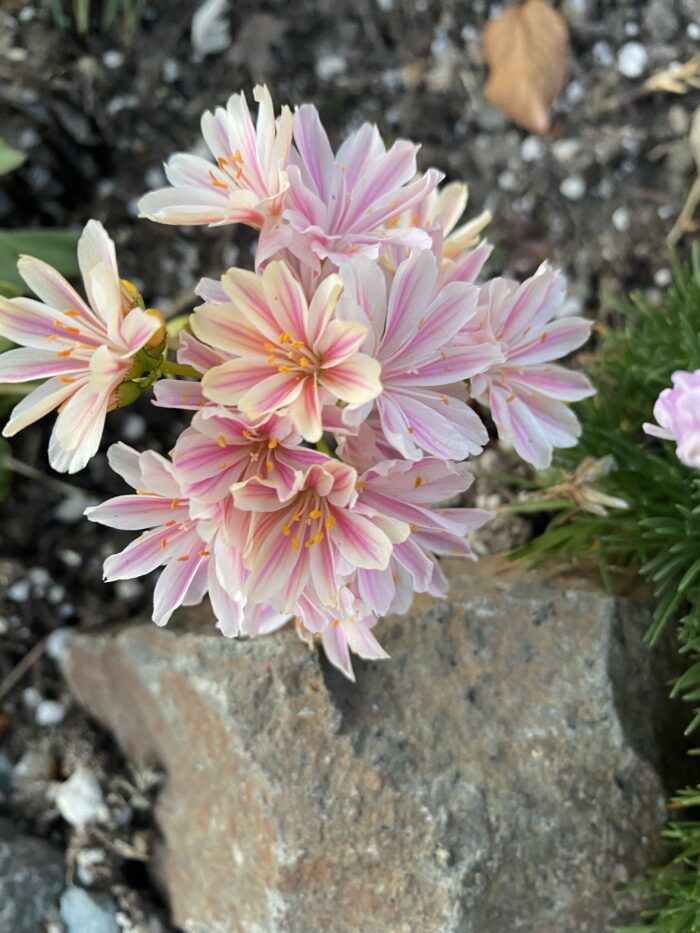
Today’s photos are from Joel, who gardens in the Pacific Northwest.
 The big purple flower heads of an allium have attracted a honeybee looking for pollen and nectar.
The big purple flower heads of an allium have attracted a honeybee looking for pollen and nectar.
 This brilliant red-and-yellow bloom comes from a red western columbine (Aquilegia formosa, Zones 4–8). While different species of columbines are native to much of the Northern Hemisphere, these strong red colors are a specialty of the species that’s native to North America, an adaptation that makes them attractive to our native hummingbirds. Gardeners in eastern North America may recognize the look from another native red columbine, Aquilegia canadensis (Zones 3–8), which looks quite similar but is a different species that has adapted the same look to lure hummingbirds.
This brilliant red-and-yellow bloom comes from a red western columbine (Aquilegia formosa, Zones 4–8). While different species of columbines are native to much of the Northern Hemisphere, these strong red colors are a specialty of the species that’s native to North America, an adaptation that makes them attractive to our native hummingbirds. Gardeners in eastern North America may recognize the look from another native red columbine, Aquilegia canadensis (Zones 3–8), which looks quite similar but is a different species that has adapted the same look to lure hummingbirds.
 A little colony of hens-and-chicks (Sempervivium hybrid, Zones 3–8), easy-to-grow hardy succulents
A little colony of hens-and-chicks (Sempervivium hybrid, Zones 3–8), easy-to-grow hardy succulents
 Though the succulent foliage is why most people choose to grow hens-and-chicks, the flowers can be pretty as well. Each individual rosette that blooms will then die, but the plant makes so many offsets that the colony will carry on.
Though the succulent foliage is why most people choose to grow hens-and-chicks, the flowers can be pretty as well. Each individual rosette that blooms will then die, but the plant makes so many offsets that the colony will carry on.
 Lewisia cotyldeon (Zones 5–8) is native to western North America, where Native Americans harvested the thick, fleshy roots as a food source. English-speaking visitors weren’t so fond of the flavor, and they gave it the common name of “bitterroot.” These days, it is grown for the beautiful blooms.
Lewisia cotyldeon (Zones 5–8) is native to western North America, where Native Americans harvested the thick, fleshy roots as a food source. English-speaking visitors weren’t so fond of the flavor, and they gave it the common name of “bitterroot.” These days, it is grown for the beautiful blooms.
 Lewisia flowers come in a wide range of colors. These beautiful plants are easy to grow in their native climate, but they can be a struggle in the wetter conditions of the eastern half of North America.
Lewisia flowers come in a wide range of colors. These beautiful plants are easy to grow in their native climate, but they can be a struggle in the wetter conditions of the eastern half of North America.
 A late-summer cloud of black-eyed Susan (Rudbeckia fulgida, Zones 3–9) fills the garden with color.
A late-summer cloud of black-eyed Susan (Rudbeckia fulgida, Zones 3–9) fills the garden with color.
If you want to see more from Joel, check out his instagram: @frondophile
Have a garden you’d like to share?
Have photos to share? We’d love to see your garden, a particular collection of plants you love, or a wonderful garden you had the chance to visit!
To submit, send 5-10 photos to [email protected] along with some information about the plants in the pictures and where you took the photos. We’d love to hear where you are located, how long you’ve been gardening, successes you are proud of, failures you learned from, hopes for the future, favorite plants, or funny stories from your garden.
Have a mobile phone? Tag your photos on Facebook, Instagram or Twitter with #FineGardening!
Do you receive the GPOD by email yet? Sign up here.

















Comments
Love that Lewisia.
Seconded!
The Lewisia is amazing and quite exotic looking to an east coast gardener. Thanks for sharing. Also love the detail in the photo of the honeybee on the allium.
Interesting to learn about the two different native columbines.
Your photography of the mother hen and chicks that has the flowers in focus and the green part of the plant out of focus is just amazing...it's as if the flowers are popping out of my computer screen they look so real!
What a gorgeous scene of the water and the Black Eyed Susans, they look amazing in a big garden that allows them to cover so much space!
Your garden looks happy and looking at your photos made ME happy!
Thank you for sharing your garden :)
Log in or create an account to post a comment.
Sign up Log in